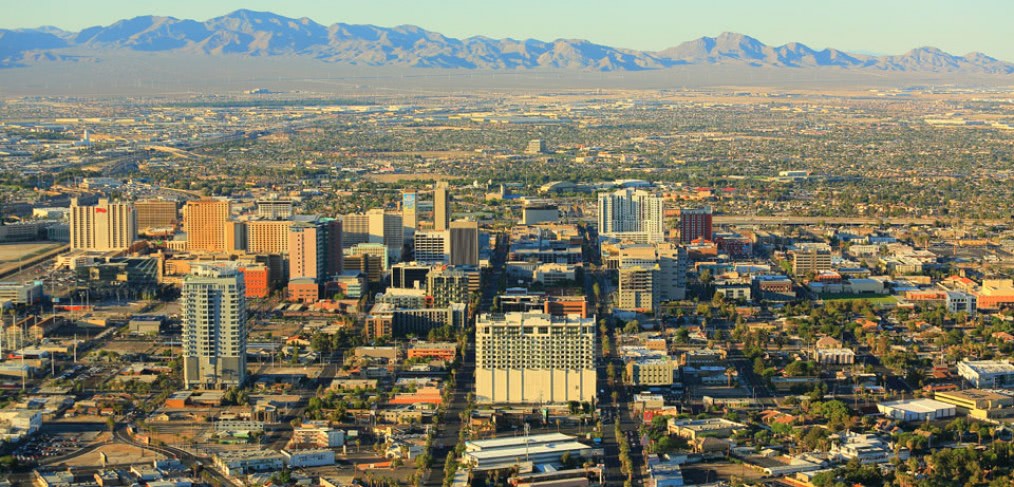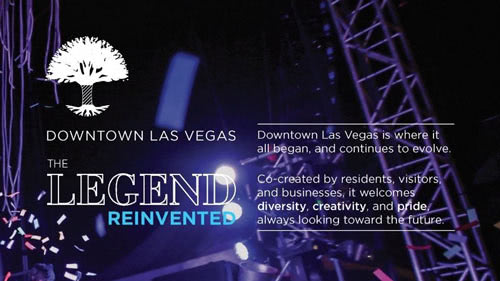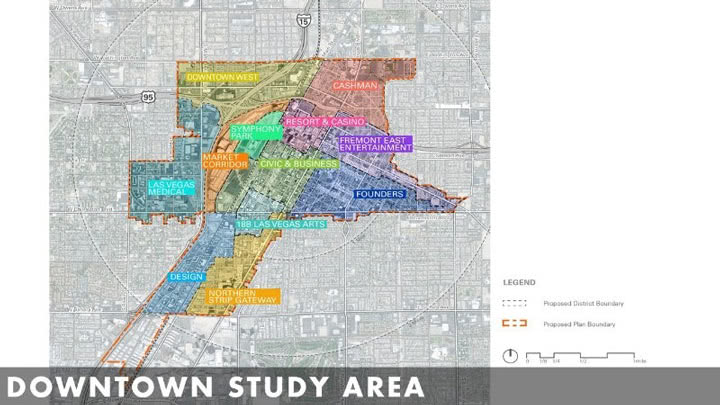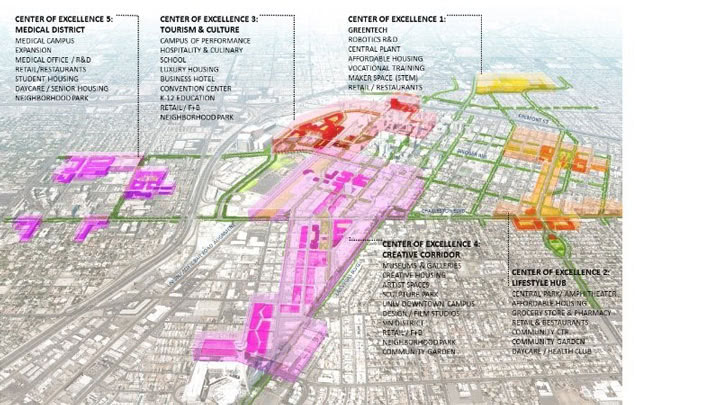
Game Changing Plans
On October 1, an outreach event in Las Vegas intended to solicit input from stakeholders and residents on a new master plan for the downtown area began to correct the path forged by decades of haphazard, opportunistic development. It could not have come at a better time.
Founded in 1905, the city of Las Vegas has never had a visionary, strategic plan for its downtown area, instead succumbing to the ebb and flow of market demand to determine its built environment. If you aren’t familiar with downtown Las Vegas, we are not referring to “the strip.” Instead, the area in question is the city’s original central business district, which includes Fremont Street. With its low taxes, funky hipster vibe and creative mix of arts, events, and startups, downtown is enjoying a noteworthy renaissance, especially in the eyes of the younger generation.
Downtown Las Vegas hosted over 20 million visitors in 2014. As the local urban population increases alongside this mass of tourists, a number of key issues are rising to the fore that the new master plan, led by CallisonRTKL along with local and international consultants, will seek to address:
- Economic diversification and investment. Although downtown can leverage core advantages in tourism, medical, high tech, robotics, and the arts, its current investment levels are significantly lower when compared to similarly sized cities.
- Poverty and homelessness. The homeless rate in downtown is over 200% higher than other communities in Clark County.
- Housing vacancy. Much of the downtown housing stock is in need of upgrades, resulting in vacancies almost 300% higher than the county average.
- Lack of parks and open space. Only 2% of the downtown area is dedicated to green space— 25% less than that of similar desert cities, such as Los Angeles and Phoenix.
- Auto orientation. Downtown Las Vegas is still heavily dependent on the automobile: 91% of all trips are taken by car.
The study area includes roughly 5.5 square miles that stretch from Rancho Drive to the west, Five Points to the east, Washington Avenue to the north and Sahara Avenue to the south. These perimeters encompass a dozen downtown districts—18B Las Vegas Art District, Atomic Highway, Courthouse District, Cultural Corridor, Fremont District, Glitter Gulch, Helen J. Stewart, Warehouse District, Market District, Medical District, Pioneer Park and Symphony Park.
Rapid diversification in the downtown area has resulted in a greater arts and cultural presence, evidenced by recent events like Life is Beautiful and the addition of facilities like The Smith Center, and a complementary mix of uses has emerged. For example, the number of bars and restaurants opened in recent years is a 250% increase over pre-recession numbers. Entrepreneurs have also flocked to the area, drawn by benefits like the district-wide high-speed fiber optic cable. Yet along with this progress is a dire need for aggressive investment in education and affordable housing that will enable the community to thrive.
OUTREACH
The master plan effort is one of the most ambitious public outreach efforts ever undertaken by the City. Over the course of the first year, the team has interviewed hundreds of stakeholders, hosted more than two dozen outreach events and steering committee meetings attended by close to 1,000 residents, and met with City Council members. Add to that over 200 site visits and the creation of an online portal for the study that has had, to date, more than 17,000 hits.
With all of these voices in the mix, one would think it might be impossible to come to a consensus. Yet Las Vegas residents are actually in agreement on the future of downtown more than they might  realize. When asked what game-changing elements are most needed to spur transformation, 42% said mixed-use hubs, 36% said urban retail and entertainment, and 30% said green streets. Poll results suggest that the community is ready to make a significant investment in a more proactive land use plan. Yes, there are costs involved, but the long-term costs of deferred investment are even greater. The challenge is to target investment in the short-term that delivers on these worthy goals while expanding the plan’s vision to include long-term resiliency.
realize. When asked what game-changing elements are most needed to spur transformation, 42% said mixed-use hubs, 36% said urban retail and entertainment, and 30% said green streets. Poll results suggest that the community is ready to make a significant investment in a more proactive land use plan. Yes, there are costs involved, but the long-term costs of deferred investment are even greater. The challenge is to target investment in the short-term that delivers on these worthy goals while expanding the plan’s vision to include long-term resiliency.
The master planning vision, dubbed “The Legend Reinvented,” is the result of extensive stakeholder input, review by City Council, and ongoing refinement. It represents the three primary demographic trends impacting the downtown area: continued growth of casinos and tourism, increasing diversity and influx of the youth population, and the spirit of collaboration fostered by recently-settled entrepreneurs.
BENEFITS
Over the next two decades, dependent upon incentives and processes implemented by the city, a coordinated master plan could yield:
- Up to 10 million GSF of mixed-use development clustered around new transit hubs
- 4,000 to 5,000 new housing units in a variety of formats
- Up to 30 acres of open space—more than a 1,500% increase—including a new central park with community based programming
- Extensive tree canopy and urban streetscape, creating more than 30 linear miles of green streets and urban trails
- Extensive light-rail transit and bus system linking downtown to UNLV, the Airport, Springs Preserve and beyond
- A new grocery store, drugstore, movie theatre, community center and other amenities
- 1-2 million GSF of creative office space and research and development facilities targeting medical, robotics and creative industries
- New cultural and education facilities, including a modern art museum, K12 school and vocational training center
- Expanded community services, including a wayfinding and safety program, homeless services, senior housing, and energy, water, and waste management
We will continue to work with the community to solicit valuable input that will shape the future of downtown Las Vegas. We invite residents and stakeholders to contribute by reviewing the documents produced thus far, leaving a comment or participating in the next outreach event in January 2016.


